System Analysis and Design Report: Healthcare System Analysis
VerifiedAdded on 2023/01/23
|11
|1588
|72
Report
AI Summary
This report presents a system analysis and design for a healthcare organization, specifically focusing on Headspace. It begins with a stakeholder map, identifying internal and external stakeholders and their interests. The report then includes questionnaires designed to gather insights from staff and patients regarding a new system. A use case diagram illustrates the interactions between medical staff, patients, and the system, followed by detailed use case descriptions and a use case table outlining various functionalities. A fully developed use case example is provided, detailing the treatment process. The report concludes with a bibliography of relevant sources. The analysis aims to provide a framework for understanding and improving the healthcare system's functionality and user experience, focusing on mental health services for youth.
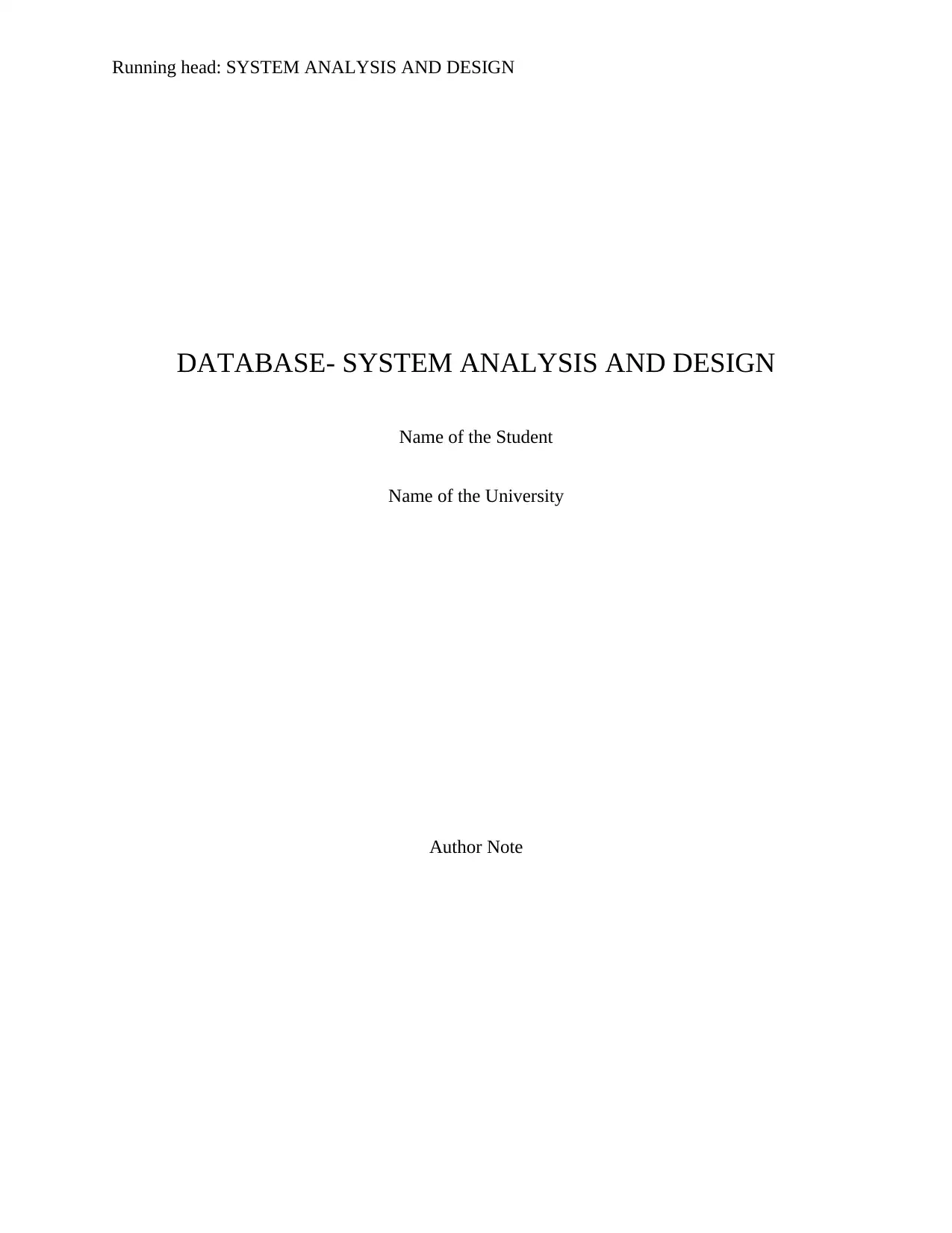
Running head: SYSTEM ANALYSIS AND DESIGN
DATABASE- SYSTEM ANALYSIS AND DESIGN
Name of the Student
Name of the University
Author Note
DATABASE- SYSTEM ANALYSIS AND DESIGN
Name of the Student
Name of the University
Author Note
Paraphrase This Document
Need a fresh take? Get an instant paraphrase of this document with our AI Paraphraser
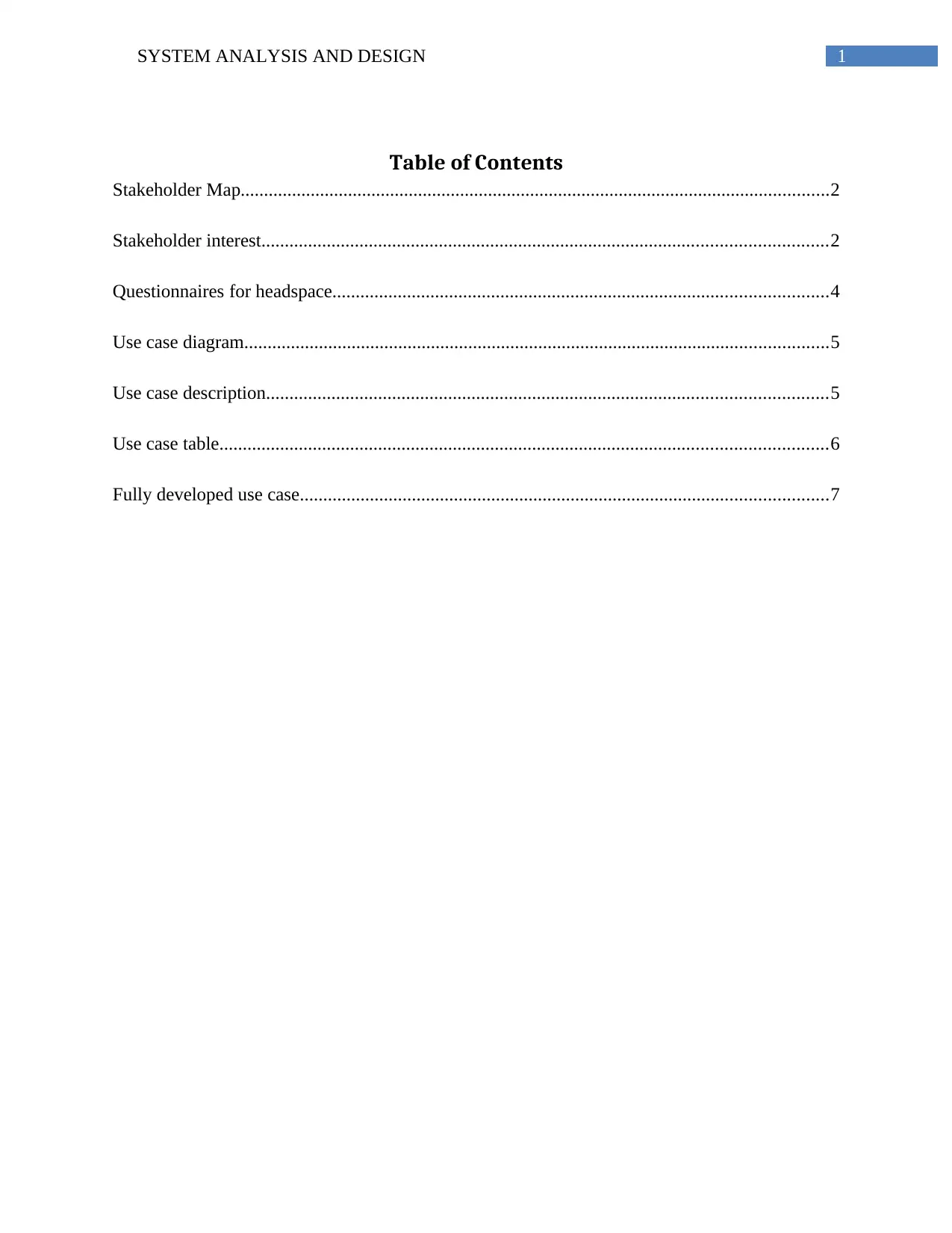
1SYSTEM ANALYSIS AND DESIGN
Table of Contents
Stakeholder Map..............................................................................................................................2
Stakeholder interest.........................................................................................................................2
Questionnaires for headspace..........................................................................................................4
Use case diagram.............................................................................................................................5
Use case description........................................................................................................................5
Use case table..................................................................................................................................6
Fully developed use case.................................................................................................................7
Table of Contents
Stakeholder Map..............................................................................................................................2
Stakeholder interest.........................................................................................................................2
Questionnaires for headspace..........................................................................................................4
Use case diagram.............................................................................................................................5
Use case description........................................................................................................................5
Use case table..................................................................................................................................6
Fully developed use case.................................................................................................................7
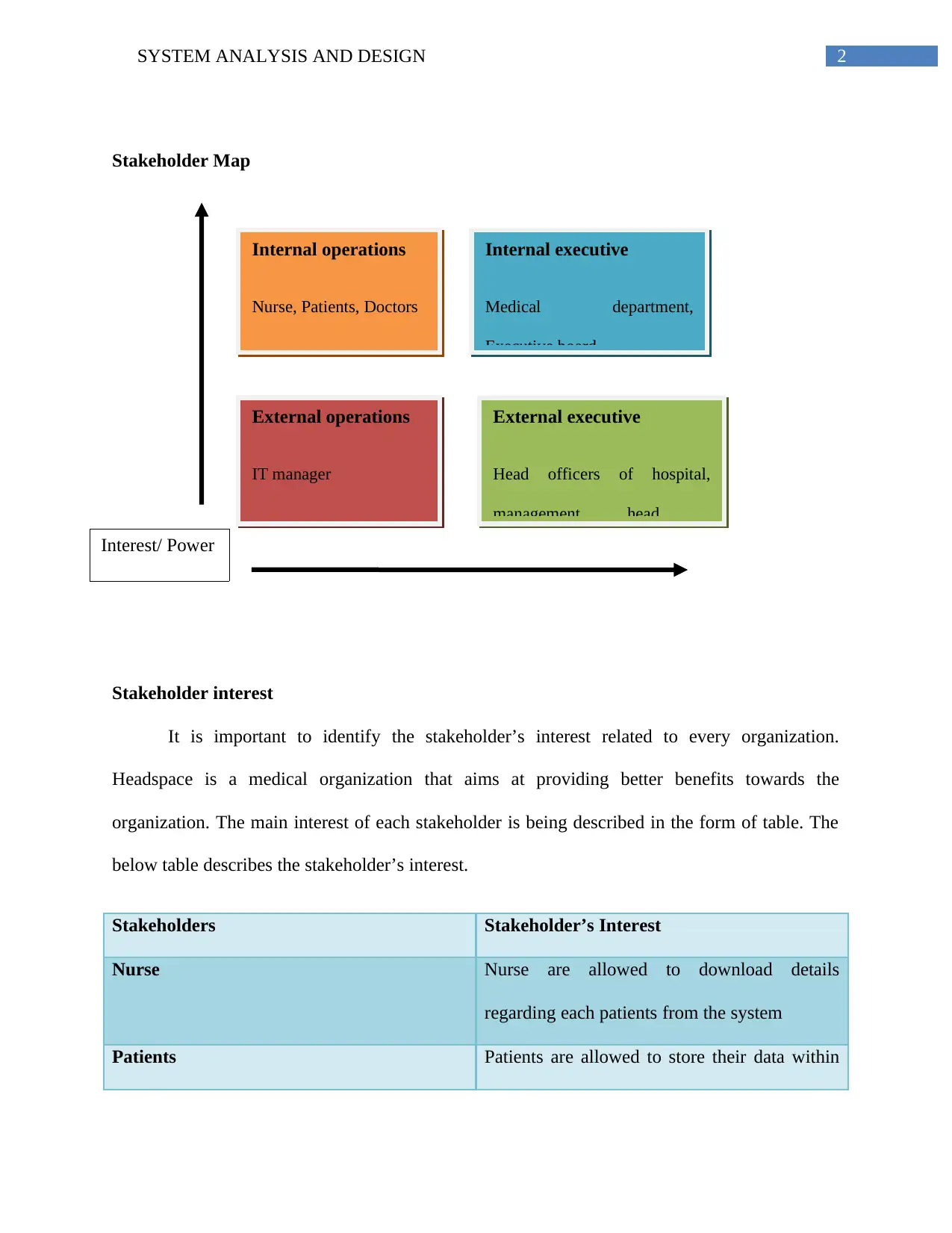
2SYSTEM ANALYSIS AND DESIGN
Stakeholder Map
Stakeholder interest
It is important to identify the stakeholder’s interest related to every organization.
Headspace is a medical organization that aims at providing better benefits towards the
organization. The main interest of each stakeholder is being described in the form of table. The
below table describes the stakeholder’s interest.
Stakeholders Stakeholder’s Interest
Nurse Nurse are allowed to download details
regarding each patients from the system
Patients Patients are allowed to store their data within
Internal operations
Nurse, Patients, Doctors
External operations
IT manager
External executive
Head officers of hospital,
management head ,
Internal executive
Medical department,
Executive board
Interest/ Power
Stakeholder Map
Stakeholder interest
It is important to identify the stakeholder’s interest related to every organization.
Headspace is a medical organization that aims at providing better benefits towards the
organization. The main interest of each stakeholder is being described in the form of table. The
below table describes the stakeholder’s interest.
Stakeholders Stakeholder’s Interest
Nurse Nurse are allowed to download details
regarding each patients from the system
Patients Patients are allowed to store their data within
Internal operations
Nurse, Patients, Doctors
External operations
IT manager
External executive
Head officers of hospital,
management head ,
Internal executive
Medical department,
Executive board
Interest/ Power
⊘ This is a preview!⊘
Do you want full access?
Subscribe today to unlock all pages.

Trusted by 1+ million students worldwide
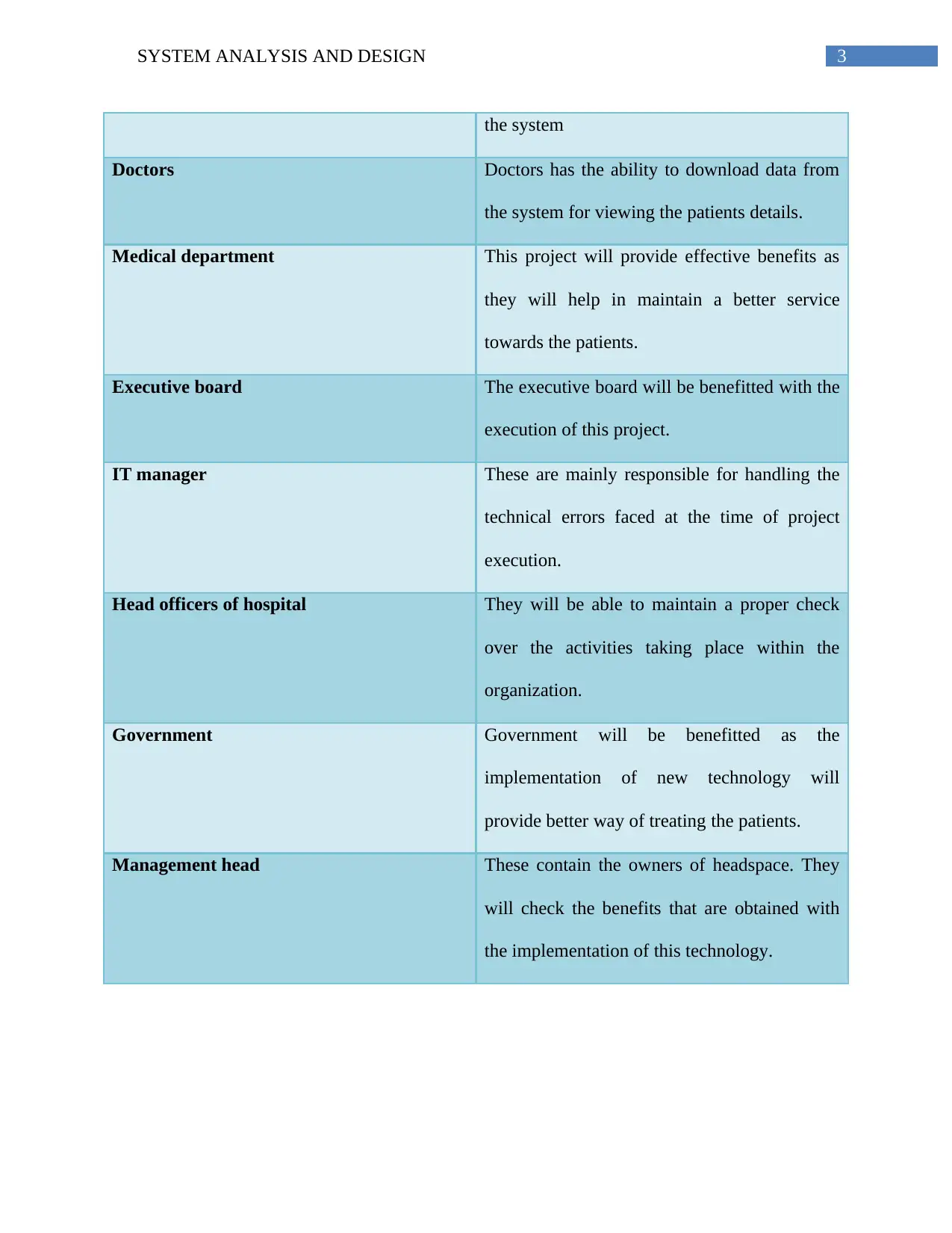
3SYSTEM ANALYSIS AND DESIGN
the system
Doctors Doctors has the ability to download data from
the system for viewing the patients details.
Medical department This project will provide effective benefits as
they will help in maintain a better service
towards the patients.
Executive board The executive board will be benefitted with the
execution of this project.
IT manager These are mainly responsible for handling the
technical errors faced at the time of project
execution.
Head officers of hospital They will be able to maintain a proper check
over the activities taking place within the
organization.
Government Government will be benefitted as the
implementation of new technology will
provide better way of treating the patients.
Management head These contain the owners of headspace. They
will check the benefits that are obtained with
the implementation of this technology.
the system
Doctors Doctors has the ability to download data from
the system for viewing the patients details.
Medical department This project will provide effective benefits as
they will help in maintain a better service
towards the patients.
Executive board The executive board will be benefitted with the
execution of this project.
IT manager These are mainly responsible for handling the
technical errors faced at the time of project
execution.
Head officers of hospital They will be able to maintain a proper check
over the activities taking place within the
organization.
Government Government will be benefitted as the
implementation of new technology will
provide better way of treating the patients.
Management head These contain the owners of headspace. They
will check the benefits that are obtained with
the implementation of this technology.
Paraphrase This Document
Need a fresh take? Get an instant paraphrase of this document with our AI Paraphraser
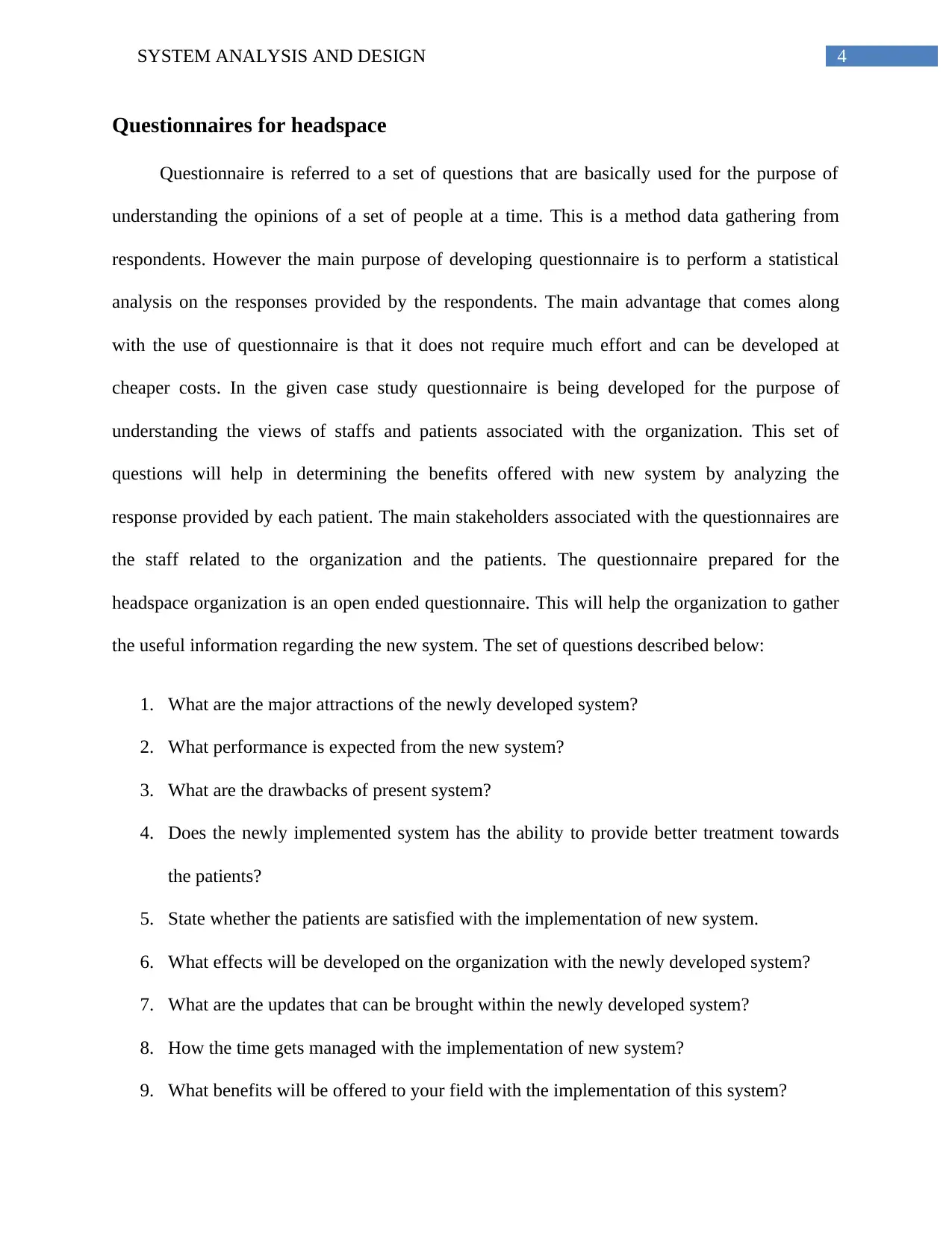
4SYSTEM ANALYSIS AND DESIGN
Questionnaires for headspace
Questionnaire is referred to a set of questions that are basically used for the purpose of
understanding the opinions of a set of people at a time. This is a method data gathering from
respondents. However the main purpose of developing questionnaire is to perform a statistical
analysis on the responses provided by the respondents. The main advantage that comes along
with the use of questionnaire is that it does not require much effort and can be developed at
cheaper costs. In the given case study questionnaire is being developed for the purpose of
understanding the views of staffs and patients associated with the organization. This set of
questions will help in determining the benefits offered with new system by analyzing the
response provided by each patient. The main stakeholders associated with the questionnaires are
the staff related to the organization and the patients. The questionnaire prepared for the
headspace organization is an open ended questionnaire. This will help the organization to gather
the useful information regarding the new system. The set of questions described below:
1. What are the major attractions of the newly developed system?
2. What performance is expected from the new system?
3. What are the drawbacks of present system?
4. Does the newly implemented system has the ability to provide better treatment towards
the patients?
5. State whether the patients are satisfied with the implementation of new system.
6. What effects will be developed on the organization with the newly developed system?
7. What are the updates that can be brought within the newly developed system?
8. How the time gets managed with the implementation of new system?
9. What benefits will be offered to your field with the implementation of this system?
Questionnaires for headspace
Questionnaire is referred to a set of questions that are basically used for the purpose of
understanding the opinions of a set of people at a time. This is a method data gathering from
respondents. However the main purpose of developing questionnaire is to perform a statistical
analysis on the responses provided by the respondents. The main advantage that comes along
with the use of questionnaire is that it does not require much effort and can be developed at
cheaper costs. In the given case study questionnaire is being developed for the purpose of
understanding the views of staffs and patients associated with the organization. This set of
questions will help in determining the benefits offered with new system by analyzing the
response provided by each patient. The main stakeholders associated with the questionnaires are
the staff related to the organization and the patients. The questionnaire prepared for the
headspace organization is an open ended questionnaire. This will help the organization to gather
the useful information regarding the new system. The set of questions described below:
1. What are the major attractions of the newly developed system?
2. What performance is expected from the new system?
3. What are the drawbacks of present system?
4. Does the newly implemented system has the ability to provide better treatment towards
the patients?
5. State whether the patients are satisfied with the implementation of new system.
6. What effects will be developed on the organization with the newly developed system?
7. What are the updates that can be brought within the newly developed system?
8. How the time gets managed with the implementation of new system?
9. What benefits will be offered to your field with the implementation of this system?
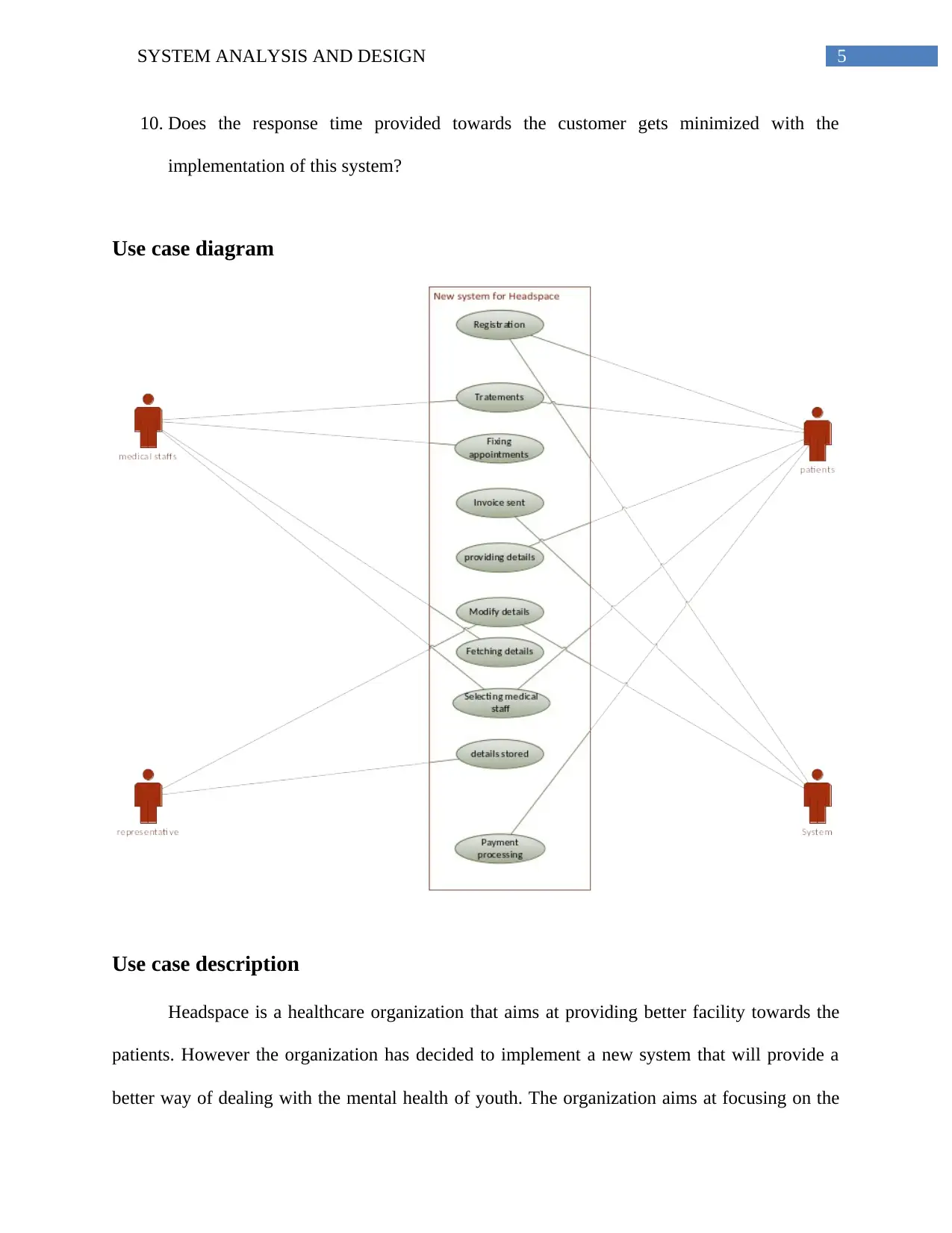
5SYSTEM ANALYSIS AND DESIGN
10. Does the response time provided towards the customer gets minimized with the
implementation of this system?
Use case diagram
Use case description
Headspace is a healthcare organization that aims at providing better facility towards the
patients. However the organization has decided to implement a new system that will provide a
better way of dealing with the mental health of youth. The organization aims at focusing on the
10. Does the response time provided towards the customer gets minimized with the
implementation of this system?
Use case diagram
Use case description
Headspace is a healthcare organization that aims at providing better facility towards the
patients. However the organization has decided to implement a new system that will provide a
better way of dealing with the mental health of youth. The organization aims at focusing on the
⊘ This is a preview!⊘
Do you want full access?
Subscribe today to unlock all pages.

Trusted by 1+ million students worldwide
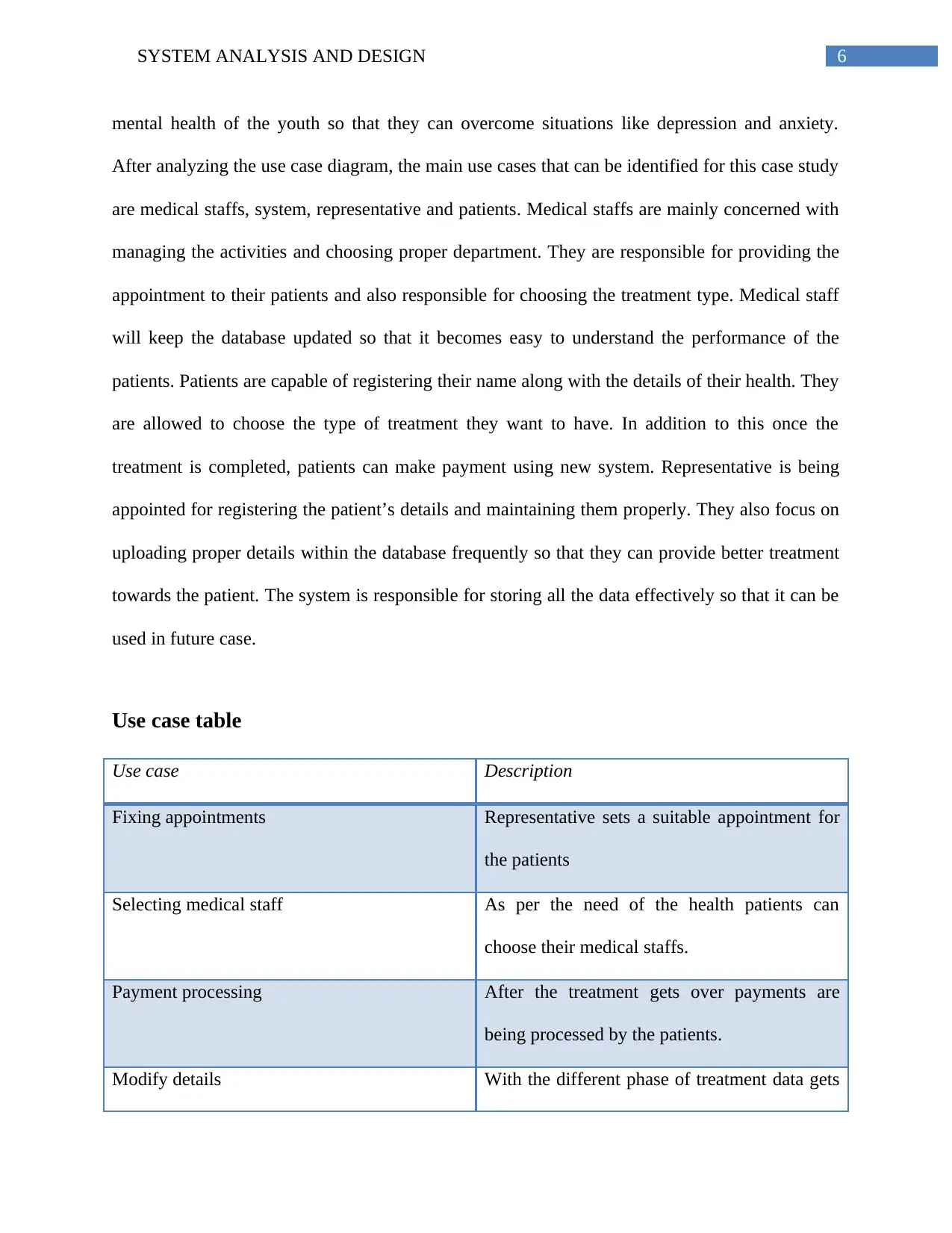
6SYSTEM ANALYSIS AND DESIGN
mental health of the youth so that they can overcome situations like depression and anxiety.
After analyzing the use case diagram, the main use cases that can be identified for this case study
are medical staffs, system, representative and patients. Medical staffs are mainly concerned with
managing the activities and choosing proper department. They are responsible for providing the
appointment to their patients and also responsible for choosing the treatment type. Medical staff
will keep the database updated so that it becomes easy to understand the performance of the
patients. Patients are capable of registering their name along with the details of their health. They
are allowed to choose the type of treatment they want to have. In addition to this once the
treatment is completed, patients can make payment using new system. Representative is being
appointed for registering the patient’s details and maintaining them properly. They also focus on
uploading proper details within the database frequently so that they can provide better treatment
towards the patient. The system is responsible for storing all the data effectively so that it can be
used in future case.
Use case table
Use case Description
Fixing appointments Representative sets a suitable appointment for
the patients
Selecting medical staff As per the need of the health patients can
choose their medical staffs.
Payment processing After the treatment gets over payments are
being processed by the patients.
Modify details With the different phase of treatment data gets
mental health of the youth so that they can overcome situations like depression and anxiety.
After analyzing the use case diagram, the main use cases that can be identified for this case study
are medical staffs, system, representative and patients. Medical staffs are mainly concerned with
managing the activities and choosing proper department. They are responsible for providing the
appointment to their patients and also responsible for choosing the treatment type. Medical staff
will keep the database updated so that it becomes easy to understand the performance of the
patients. Patients are capable of registering their name along with the details of their health. They
are allowed to choose the type of treatment they want to have. In addition to this once the
treatment is completed, patients can make payment using new system. Representative is being
appointed for registering the patient’s details and maintaining them properly. They also focus on
uploading proper details within the database frequently so that they can provide better treatment
towards the patient. The system is responsible for storing all the data effectively so that it can be
used in future case.
Use case table
Use case Description
Fixing appointments Representative sets a suitable appointment for
the patients
Selecting medical staff As per the need of the health patients can
choose their medical staffs.
Payment processing After the treatment gets over payments are
being processed by the patients.
Modify details With the different phase of treatment data gets
Paraphrase This Document
Need a fresh take? Get an instant paraphrase of this document with our AI Paraphraser
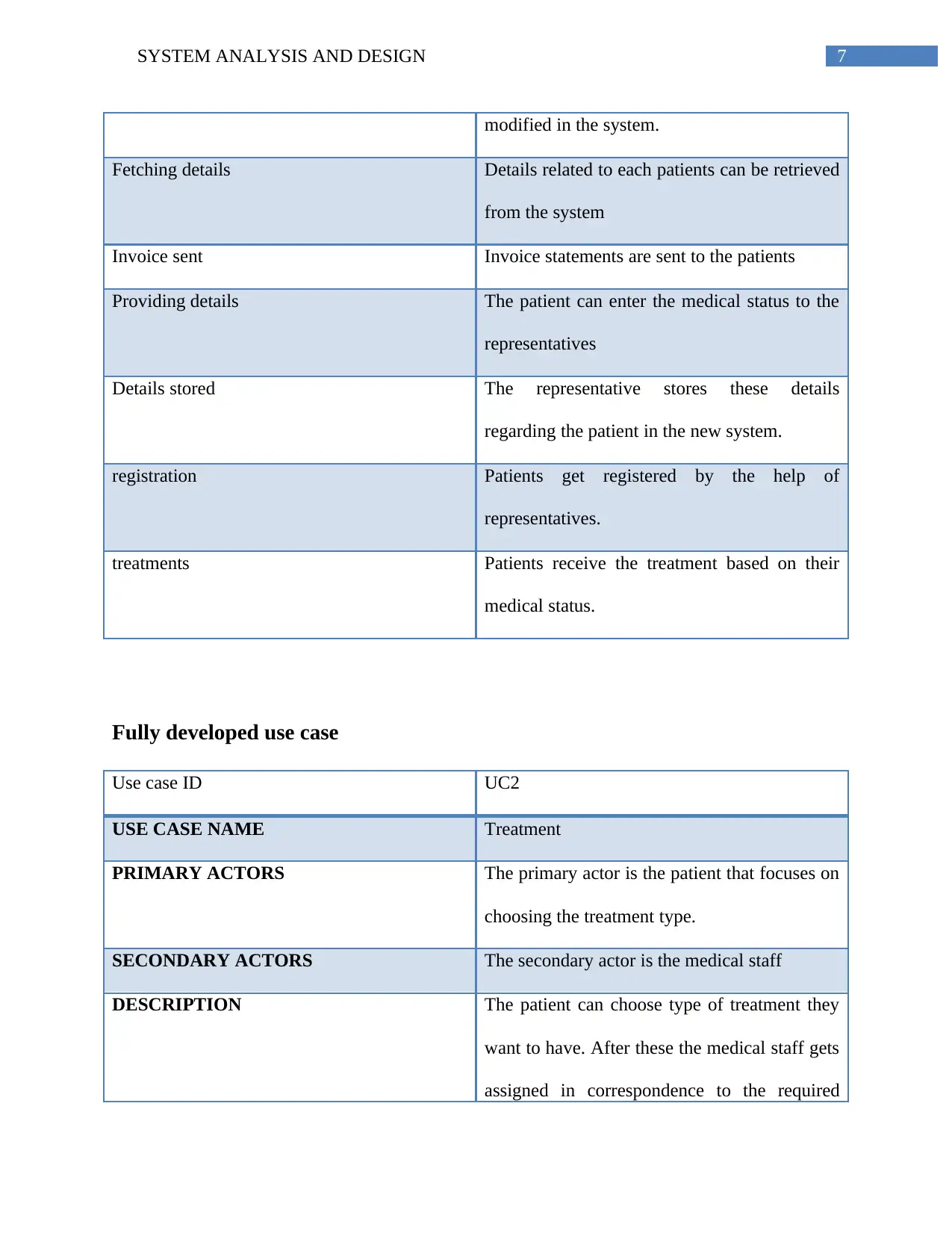
7SYSTEM ANALYSIS AND DESIGN
modified in the system.
Fetching details Details related to each patients can be retrieved
from the system
Invoice sent Invoice statements are sent to the patients
Providing details The patient can enter the medical status to the
representatives
Details stored The representative stores these details
regarding the patient in the new system.
registration Patients get registered by the help of
representatives.
treatments Patients receive the treatment based on their
medical status.
Fully developed use case
Use case ID UC2
USE CASE NAME Treatment
PRIMARY ACTORS The primary actor is the patient that focuses on
choosing the treatment type.
SECONDARY ACTORS The secondary actor is the medical staff
DESCRIPTION The patient can choose type of treatment they
want to have. After these the medical staff gets
assigned in correspondence to the required
modified in the system.
Fetching details Details related to each patients can be retrieved
from the system
Invoice sent Invoice statements are sent to the patients
Providing details The patient can enter the medical status to the
representatives
Details stored The representative stores these details
regarding the patient in the new system.
registration Patients get registered by the help of
representatives.
treatments Patients receive the treatment based on their
medical status.
Fully developed use case
Use case ID UC2
USE CASE NAME Treatment
PRIMARY ACTORS The primary actor is the patient that focuses on
choosing the treatment type.
SECONDARY ACTORS The secondary actor is the medical staff
DESCRIPTION The patient can choose type of treatment they
want to have. After these the medical staff gets
assigned in correspondence to the required
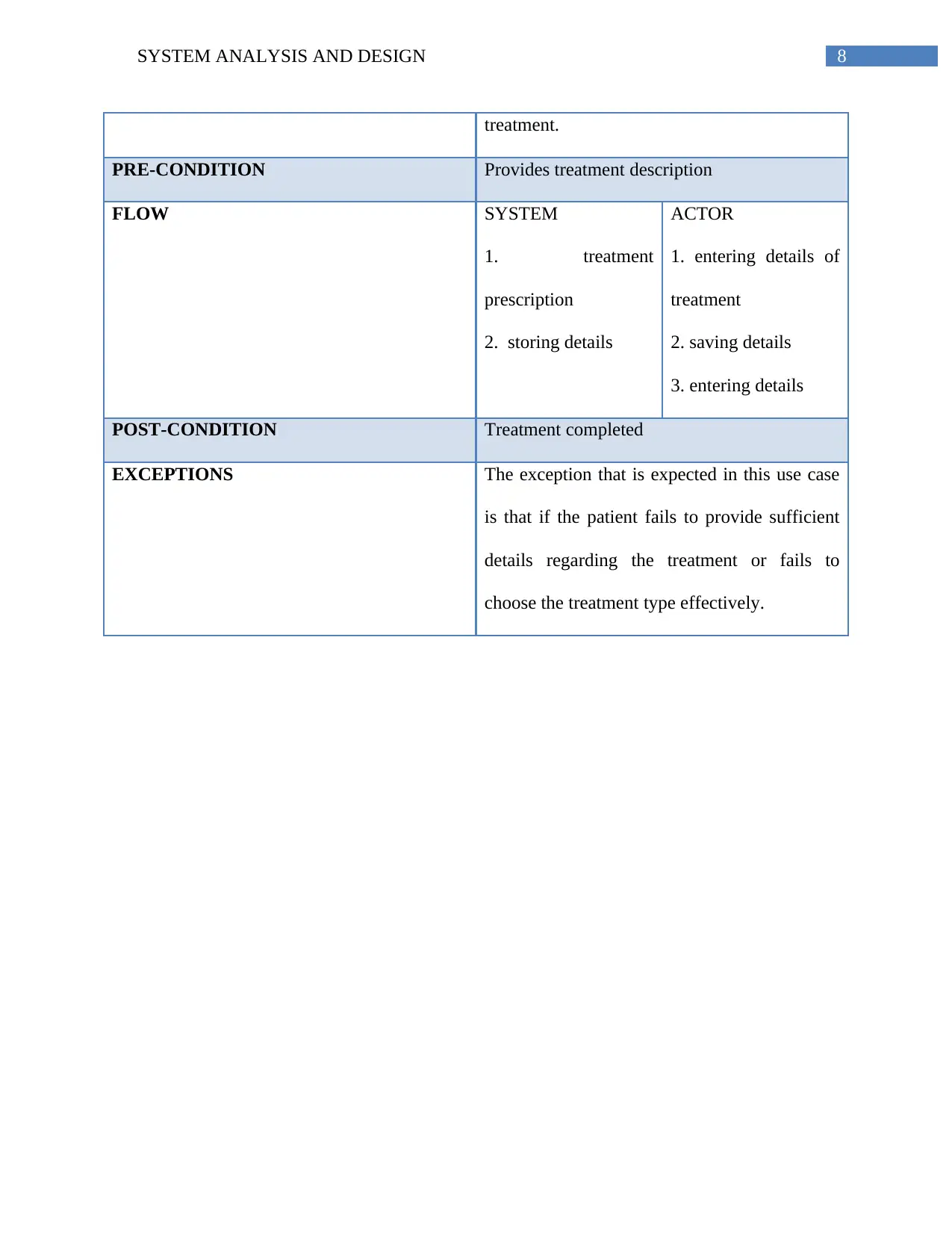
8SYSTEM ANALYSIS AND DESIGN
treatment.
PRE-CONDITION Provides treatment description
FLOW SYSTEM
1. treatment
prescription
2. storing details
ACTOR
1. entering details of
treatment
2. saving details
3. entering details
POST-CONDITION Treatment completed
EXCEPTIONS The exception that is expected in this use case
is that if the patient fails to provide sufficient
details regarding the treatment or fails to
choose the treatment type effectively.
treatment.
PRE-CONDITION Provides treatment description
FLOW SYSTEM
1. treatment
prescription
2. storing details
ACTOR
1. entering details of
treatment
2. saving details
3. entering details
POST-CONDITION Treatment completed
EXCEPTIONS The exception that is expected in this use case
is that if the patient fails to provide sufficient
details regarding the treatment or fails to
choose the treatment type effectively.
⊘ This is a preview!⊘
Do you want full access?
Subscribe today to unlock all pages.

Trusted by 1+ million students worldwide
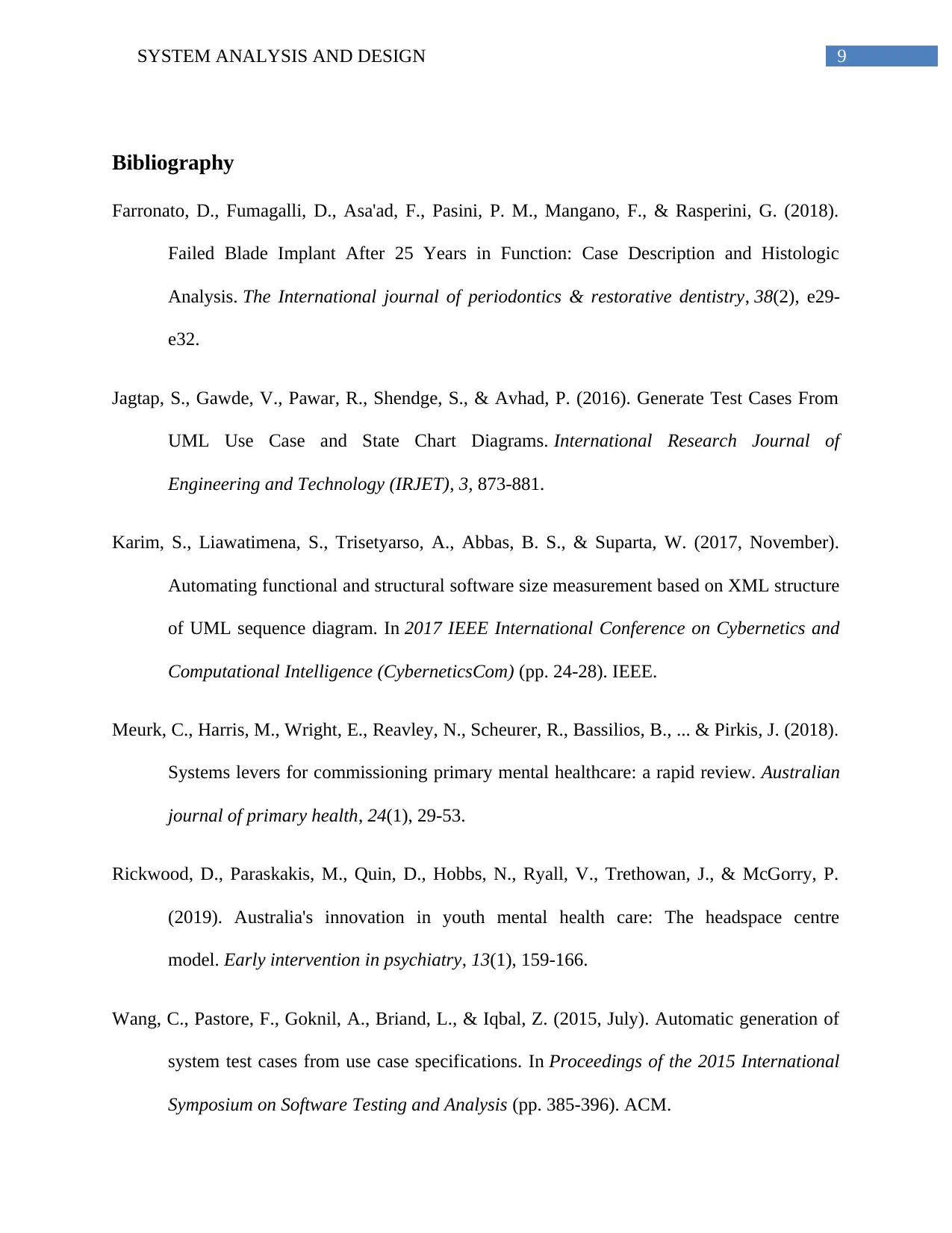
9SYSTEM ANALYSIS AND DESIGN
Bibliography
Farronato, D., Fumagalli, D., Asa'ad, F., Pasini, P. M., Mangano, F., & Rasperini, G. (2018).
Failed Blade Implant After 25 Years in Function: Case Description and Histologic
Analysis. The International journal of periodontics & restorative dentistry, 38(2), e29-
e32.
Jagtap, S., Gawde, V., Pawar, R., Shendge, S., & Avhad, P. (2016). Generate Test Cases From
UML Use Case and State Chart Diagrams. International Research Journal of
Engineering and Technology (IRJET), 3, 873-881.
Karim, S., Liawatimena, S., Trisetyarso, A., Abbas, B. S., & Suparta, W. (2017, November).
Automating functional and structural software size measurement based on XML structure
of UML sequence diagram. In 2017 IEEE International Conference on Cybernetics and
Computational Intelligence (CyberneticsCom) (pp. 24-28). IEEE.
Meurk, C., Harris, M., Wright, E., Reavley, N., Scheurer, R., Bassilios, B., ... & Pirkis, J. (2018).
Systems levers for commissioning primary mental healthcare: a rapid review. Australian
journal of primary health, 24(1), 29-53.
Rickwood, D., Paraskakis, M., Quin, D., Hobbs, N., Ryall, V., Trethowan, J., & McGorry, P.
(2019). Australia's innovation in youth mental health care: The headspace centre
model. Early intervention in psychiatry, 13(1), 159-166.
Wang, C., Pastore, F., Goknil, A., Briand, L., & Iqbal, Z. (2015, July). Automatic generation of
system test cases from use case specifications. In Proceedings of the 2015 International
Symposium on Software Testing and Analysis (pp. 385-396). ACM.
Bibliography
Farronato, D., Fumagalli, D., Asa'ad, F., Pasini, P. M., Mangano, F., & Rasperini, G. (2018).
Failed Blade Implant After 25 Years in Function: Case Description and Histologic
Analysis. The International journal of periodontics & restorative dentistry, 38(2), e29-
e32.
Jagtap, S., Gawde, V., Pawar, R., Shendge, S., & Avhad, P. (2016). Generate Test Cases From
UML Use Case and State Chart Diagrams. International Research Journal of
Engineering and Technology (IRJET), 3, 873-881.
Karim, S., Liawatimena, S., Trisetyarso, A., Abbas, B. S., & Suparta, W. (2017, November).
Automating functional and structural software size measurement based on XML structure
of UML sequence diagram. In 2017 IEEE International Conference on Cybernetics and
Computational Intelligence (CyberneticsCom) (pp. 24-28). IEEE.
Meurk, C., Harris, M., Wright, E., Reavley, N., Scheurer, R., Bassilios, B., ... & Pirkis, J. (2018).
Systems levers for commissioning primary mental healthcare: a rapid review. Australian
journal of primary health, 24(1), 29-53.
Rickwood, D., Paraskakis, M., Quin, D., Hobbs, N., Ryall, V., Trethowan, J., & McGorry, P.
(2019). Australia's innovation in youth mental health care: The headspace centre
model. Early intervention in psychiatry, 13(1), 159-166.
Wang, C., Pastore, F., Goknil, A., Briand, L., & Iqbal, Z. (2015, July). Automatic generation of
system test cases from use case specifications. In Proceedings of the 2015 International
Symposium on Software Testing and Analysis (pp. 385-396). ACM.
Paraphrase This Document
Need a fresh take? Get an instant paraphrase of this document with our AI Paraphraser

10SYSTEM ANALYSIS AND DESIGN
Zwagerman, M. D. (2015). High level synthesis, a use case comparison with hardware
description language.
Zwagerman, M. D. (2015). High level synthesis, a use case comparison with hardware
description language.
1 out of 11
Related Documents
Your All-in-One AI-Powered Toolkit for Academic Success.
+13062052269
info@desklib.com
Available 24*7 on WhatsApp / Email
![[object Object]](/_next/static/media/star-bottom.7253800d.svg)
Unlock your academic potential
Copyright © 2020–2025 A2Z Services. All Rights Reserved. Developed and managed by ZUCOL.




